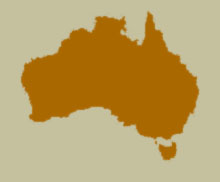Synonyms
Bucolus fourneti Mulsant, 1850: 1000.
Bucolus nuytsiae Lea, 1902: 508.
Bucolus nigripes Lea, 1902: 508.
Bucolus obscurus Lea, 1902: 509.
Diagnosis
The broad, prosternal projection which is narrowly incised laterally, combined with the relatively flat body and broad, elytral epipleura, complete to apex, will easily distinguish this common species from the other Bucolus.
Description
Length 2.1-4.5 mm. Dorsum dark brown to almost black, often with two admedian reddish spots on elytra; mouthparts, antennae, apices of tibiae and tarsi and abdomen brown or yellow. Weakly convex, covered with very short, dense, whitish or yellowish pubescence not forming pattern on elytra; head and pronotum often with longer and more outstanding hairs; elytral margin usually with fringe of longer setae. Punctures on head distinctly finer than eye facets, separated by 1.0-1.5 diameters; intervals between punctures feebly shiny but without microsculpture. Anterior clypeal margin straight or very shallowly arcuate. Antenna slender with narrow club. Apical maxillary palpomere, as long as broad, almost parallel sided. Eyes at frons separated by about 2-2.2 times eye width. Pronotal base not margined; prosternum long in front of procoxae with a broad projection that occupies most of prosternum and is limited laterally by narrow antennal grooves. Prosternal process 0.6 times as wide as transverse coxal diameter. Hypomeron concave but without distinct foveae. Scutellum pentagonal, setose. Elytral surface densely, irregularly punctate; all punctures setigerous and of similar size, 1-2 diameters apart; interspaces feebly shiny but without noticeable microsculpture. Epipleuron broad and complete to apex, about 3 times as broad as metepisternum, narrowing posteriorly from the level of abdomen; foveae well defined; the mesofemoral fovea delimited both on metepisternum and epipleuron; the metafemoral one weakly delimited on epipleuron. Meso-metaventral junction about as wide as mesocoxa; mesoventrite straight and bordered anteriorly. Protibia short and broad, weakly angulate and almost straight along external margin of tarsal groove; mid and hind tibiae similar to each other slightly narrower and angulate externally; claws in male appendiculate with basal tooth prominent and short, in female apparently simple. Abdominal postcoxal line recurved and almost always complete; ventrite V distinctly arcuate with fine marginal line.
Male
Male genitalia as figured.
Female
Externally identical to male.
Variation
This species is very widely distributed and variable in many external characters but the male genitalia are very constant in their morphology. There are some geographical differences but in each region, most of the specimens are typical as described above with various frequencies of specimens deviating from this standard. The major variable features are: (a) colour from yellowish to black with the elytral spots present or absent; (b) dorsal setae that are usually short and appressed but in some specimens they are all distinctly longer and more hair like but, especially in South Australia, dorsal setae are double with longer outstanding setae variously distributed among the shorter ones on elytral surfaces and along the margins; (c) in most of the northern Queensland specimens, the body is more rounded and slightly more convex as compared to the southern specimens.
 Distribution and Biology
Distribution and Biology
Widely distributed all over Australia, commonly found under loose Eucalyptus bark.
Lea, A.M. 1902. Descriptions of new species of Australian Coleoptera. Proceedings of the Linnaean Society of New South Wales, 1901: 481-513.
Mulsant, M E. 1850. Species des Coléoptères Trimeres Sécuripalpes. Annales des Sciencies Physiques et Naturelles, d'Agriculture et d'Industrie, publiées par la Société nationale d'Agriculture, etc., de Lyon, Deuxicme Série, 2: xv + 1-1104 (part 1 pp. 1-450; part 2 pp. 451-1104).
Slipinski, A and Dolambi, F. 2007. Revision of the Australian Coccinellidae (Coleoptera). Part 7. Genus Bucolus Mulsant. Annales Zoologici (Warszawa), 57: 763-781.
[ Top ]
